Chapter 1
1. In case of an accident, there is a high chance of getting lost. The transportation cost is very high each
time. However, if the infrastructure is set once, it will be very easy to use it repeatedly. Time for
wireless transmission is negligible as signals travel at the speed of light.
2. Advantages of bursty data communication
(a) Pulses are made very narrow, so multipaths are resolvable
(b) The transmission device needs to be switched on for less time.
Disadvantages
(a) Bandwidth required is very high
(b) Peak transmit power can be very high.
3. Pb = 10−12
2γ = 10−12
γ = 1012
1
2 = 5 × 1011 (very high)
4. Geo: 35,786 Km above earth ⇒ RT T = 2×35786×103
= 0.2386s
Meo: 8,000- 20,000 Km above earth ⇒ RT T = 2×8000×103
Leo: 500- 2,000 Km above earth ⇒ RT T = 2×500×103
Only Leo satellites as delay = 3.3ms < 30ms
c
c
c
= 0.0033s
= 0.0533s
5.
6. optimum no. of data user = d
optimum no. of voice user = v
Three different cases:
Case 1: d=0, v=6
⇒ revenue = 60.80.2 = 0.96
Case 2: d=1, v=3
revenue = [prob. of having one data user]×(revenue of having one data user)
+ [prob. of having two data user]×(revenue of having two data user)
+ [prob. of having one voice user]×(revenue of having one voice user)
+ [prob. of having two voice user]×(revenue of having two voice user)
+ [prob. of having three or more voice user]×(revenue in this case)
⇒ 0.52
× $1 + 0.52 × $1 +
0.8 × 0.25 × $0.2 +
0.82 × 0.24 × $0.4+
0.8 × 0.25 × $0.2 −
0.82 × 0.24 × $0.4
× $0.6
2
1
1 −
6
1
6
2
6
1
6
2
⇒ $1.35
Case 3: d=2, v=0
revenue =2 × 0.5 = $1
So the best case is case 2, which is to allocate 60kHz to data and 60kHz to voice.
�
7.
8. 1. Hand-off becomes a big problem.
2. Inter-cell interference is very high and should be mitigated to get reasonable SINR.
3. Infrastructure cost is another problem.
9. Smaller the reuse distance, larger the number of users who can use the same system resource and so
10.
capacity (data rate per unit bandwidth) increases.
(a) 100 cells, 100 users/cell ⇒ 10,000 users
(b) 100 users/cell ⇒ 2500 cells required
100km2
Area/cell = 2500cells ⇒ Area
cell = .04km2
(c) From Rappaport or iteration of formula, we get that 100 channels
cell ⇒ 89 channels
cell @Pb = .02
Each subscriber generates 1
Thus, each cell can support 30 × 89 = 2670 subscribers
Macrocell: 2670 × 100 ⇒ 267, 000 subscribers
Microcell: 6,675,000 subscribers
30 of an Erlang of traffic.
(d) Macrocell: $50 M
Microcell: $1.25 B
(e) Macrocell: $13.35 M/month ⇒ 3.75 months approx 4 months to recoop
Microcell: $333.75 M/month ⇒ 3.75 months approx 4 months to recoop
11. One CDPD line : 19.2Kbps
average Wimax ∼ 40M bps
∴ number of CDPD lines ∼ 2 × 103
�
1.
(a)
Chapter 10
(AAH)T = (AH)T .AT
= (AT )T
= AAH
∴ (AAH)H = AAH
AT
For AAH , λ = λ, i.e. eigen-values are real
AAH = QΛQH
(b) X H AAH X = (X H A)(X H A)H = X H A ≥ 0
∴ AAH is positive semidefinite.
(c) IM + AAH = IM + QΛQH = Q(I + Λ)QH
AH positive semidefinite ⇒ λi ≥ 0∀i
∴ 1 + λi > 0∀i
∴ IM + AAH positive definite
(d)
det[IM + AAH] = det[IM + QΛQH]
= det[Q(IM + ΛM )QH]
= det[IM + ΛM ]
= ΠRank(A)
(1 + λi)
i=1
det[IN + AH A] = det[IN + QΛQH]
= det[Q(IN + ΛN )QH]
= det[IN + ΛN ]
= ΠRank(A)
(1 + λi)
i=1
∵ AAH and AH A have the same eigen-value
∴ det[IM + AAH] = det[IN + AH A]
2. H = UΣV T
U =
−0.4793
1.7034
Σ =
0.8685 −0.1298
−0.5896 −0.4272 −0.6855
−0.6508 −0.2513
0.7164
0
0 0.7152
0
0
0
0 0.1302
�
V =
−0.3458
V =
1 0
0 1
0 0
∴ H =
0.6849
0.4263
−0.5708
0.2191
0.0708
−0.7116 −0.6109
0.0145
−0.2198
0.3311 −0.9017
1 0
0 2
1 0
1 0 0
Σ =
0 1
0 0
0 2 0
0 0 0
3. H = UΣV T
Let
U =
4. Check the rank of each matrix
rank(HI) = 3
∴ multiplexing gain = 3
rank(H2) = 4
∴ multiplexing gain = 4
5.
6.
Vi = ρ
Constraint
λi = constant
RH
i=1
log2
C =
1 + λiρ
Mt
∴ ∂C
∂λi
=
ρ
1
Mt ln 2
(1 + λiρ
Mt
)
− ρ
Mt ln 2
1
(1 + λiρ
Mt
)
= 0
⇒ λi = λj
∴ when all RH singular values are equal, this capacity is maximized.
(a) Any method to show H ≈ UΛV is acceptable. For example:
Hij−H
Hij
× 100
(b) precoding filter M = V −1
D =
.05 .09 .14
.23 .13 .10
.13 .08 .11
where : dij =
−.5195 −.3460 −.7813
−.2407 −.8894
shaping filter F = U−1
−.0251 −.9078
.4188
−.8540
.2373
.4629
.3887
−.4727 −.2423 −.8473
−.8478
.3622
.3876
M =
F =
(c) Pi
Thus Y = F(H)MX + FN = U∗UΛVV ∗X + U∗N
= ΛX + U∗N
− 1
P = 1
γo
2P
γi = λi
NoB = 94.5 for i = 1, 6.86 for i = 2, .68 for i = 3
Assume γ2 > γ0 > γ3 since γ3 = .68 is clearly too small for data transmission
, 0 else
for 1
γi
> 1
γo
γi
�
Pi
− 1
γ2
− 1
P = 1 ⇒ 2
γ0
P = .5676 P2
P = .4324
P1
C = B
1 + γ1
log2
P1
P
= 775.9 kbps
γ1
= 1 ⇒ γ0 = 1.73
+ log2
1 + γ2
P2
P
(d) With equal weight beamforming, the beamforming vector is given by c = 1√
is then given by:
SN R = cH H H Hc
N0B
= (.78)(100) = 78.
(3)
[1 1 1]. The SNR
(1)
This gives a capacity of 630.35 kbps. The SNR achieved with beamforming is smaller than the
best channel in part (c). If we had chosen c to equal the eigenvector corresponding to the best
eigenvalue, then the SNR with beamforming would be equal to the largest SNR in part(c). The
beamforming SNR for the given c is greater than the two smallest eigenvalues in part(c) because
the channel matrix has one large eigenvalue and two very small eigenvalues.
7. C = max B log2 det[IM γ + HRX H H]
RX : Tγ(RX) = ρ If the channel is known to the transmitter, it will perform an SVD decomposition of
H as
H = UΣV
HRX H H = (UΣV )RX(UΣV )H
By Hadamard’s inequality we have that for A ∈ n×n
det(A) ≤ Πn
i=1Aii
with equality iff A is diagonal.
We choose RX to be diagonal, say = Ω then
det(IM R + HRX H H) = det(I + ΩΣ2)
∴ C = max
i ρi≤ρ
Bσi log2(1 + λiρi)
√
λi are the singular values.
where
8. The capacity of the channel is found by the decomposition of the channel into RH parallel channels,
where RH is the rank of the channel matric H.
√
λi are the RH non-zero singular values of the channel matrix H and ρ is the SNR constraint.
where
C = max
i ρi≤ρ
ρi:
i
B log2(1 + λiρi)
γi = λiρ
1
γ0
0
C =
B log2(γi/γ0)
i:γi≥γ0
Then the optimal power allocation is given as
Pi
P
=
− 1
γi
γi ≥ γ0
γi < γ0
(2)
for some cut-off value γ0. The resulting capacity is given as
�
For
H =
RH = 3, γ1 = 80, γ2 = 40, γ3 = 40. We first assume that γ0 is less than the minimum γi which is 40.
1
1 1 −1 −1
1 1
1
1
1 −1
1 1
1 1 −1
3
3
1 +
1
γi
i=1
γ0 =
C
B
= 12.4732 bits/sec/Hz
1
1 −1
1
1 −1
1
1
1 −1
1
1
1 −1 −1 −1
which gives γ0 = 2.8236 < mini γi, hence the assumption was correct.
For
H =
RH = 4, γ1 = 40, γ2 = 40, γ3 = 40, γ4 = 40. We first assume that γ0 is less than the minimum γi
which is 40.
4
4
γ0 =
1 +
1
γi
i=1
which gives γ0 = 3.6780 < mini γi, hence the assumption was correct.
h11
.
.
.
hMr1
9. H =
C
B
= 13.7720 bits/sec/Hz
Mr×Mt
h1Mt
. . .
. . .
. . .
. . .
. . . hMrMt
.
.
.
�
Denote G = HH T
lim
Mt→∞
1
Mt
Gii = lim
Mt→∞
1
Mt
= lim
Mt→∞
1
Mt
= Ejhij2
= σ2
= 1 ∀i
lim
Mt→∞,i=j
1
Mt
Gij = lim
Mt→∞
1
Mt
hi1
.
.
.
hiMt
hj1
.
.
.
hjMt
[hi1 . . . hiMt]
Mt
j=1
hij2
[hi1 . . . hiMt]
Mt
hikhjk
1
∴ lim
M→∞
M
IM + ρ
M
HH T
HH T = IM
∴ lim
M→∞ B log2 det
k=1
= lim
Mt→∞
1
Mt
= Ekhikhjk
= Ek(hik)Ek(hjk)
= 0 ∀i, j, i = j
= B log2 det [IM + ρIM ]
= B log2 [1 + ρ] det IM
= M B log2 [1 + ρ]
10. We find the capacity by randomly generating 103 channel instantiations and then averaging over it.
We assume that distribution is uniform over the instantiations.
MATLAB CODE
clear;
clc;
Mt = 1;
Mr = 1;
rho_dB = [0:25];
rho = 10.^(rho_dB/10);
for k = 1:length(rho)
for i = 1:100
H = wgn(Mr,Mt,0,’dBW’,’complex’);
[F, L, M] = svd(H);
for j = 1:min(Mt,Mr)
�
sigma(j) = L(j,j);
end
sigma_used = sigma(1:rank(H));
gamma = rho(k)*sigma_used;
%% Now we do water filling\
gammatemp = gamma;
gammatemp1 = gammatemp;
gamma0 = 1e3;
while gamma0 > gammatemp1(length(gammatemp1));
gammatemp1 = gammatemp;
gamma0 = length(gammatemp1)/(1+sum(1./gammatemp1));
gammatemp = gammatemp(1:length(gammatemp)-1);
end
C(i) = sum(log2(gammatemp1./gamma0));
end
Cergodic(k) = mean(C);
end
Figure 1: Problem 10
11. We find the capacity by randomly generating 104 channel instantiations and then averaging over it.
We assume that distribution is uniform over the instantiations.
MATLAB CODE
clear;
clc;
Mt = 1;
05101520250510152025ρ (dB)CergodicMt = Mr = 3Mt = 2 Mr =3Mt = Mr = 2Mt = 2 Mr =1Mt = Mr = 1�
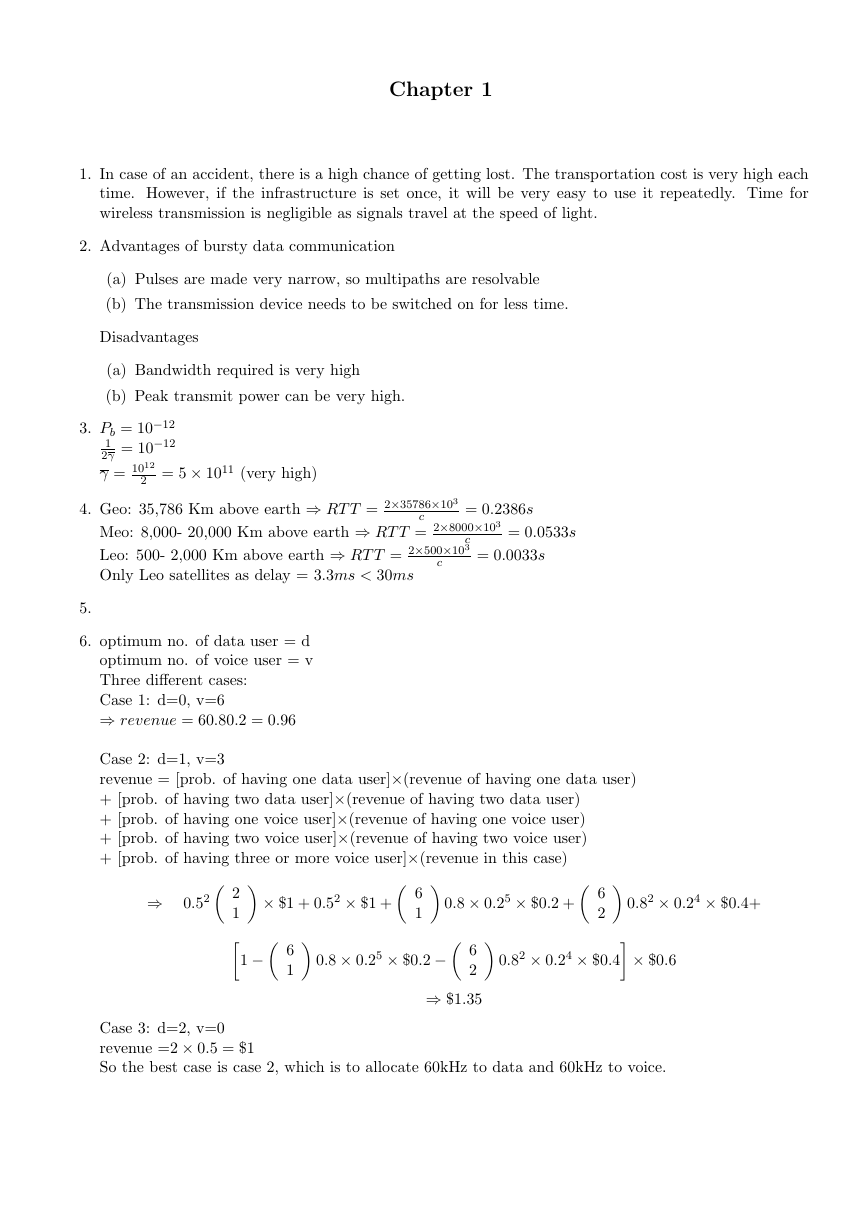
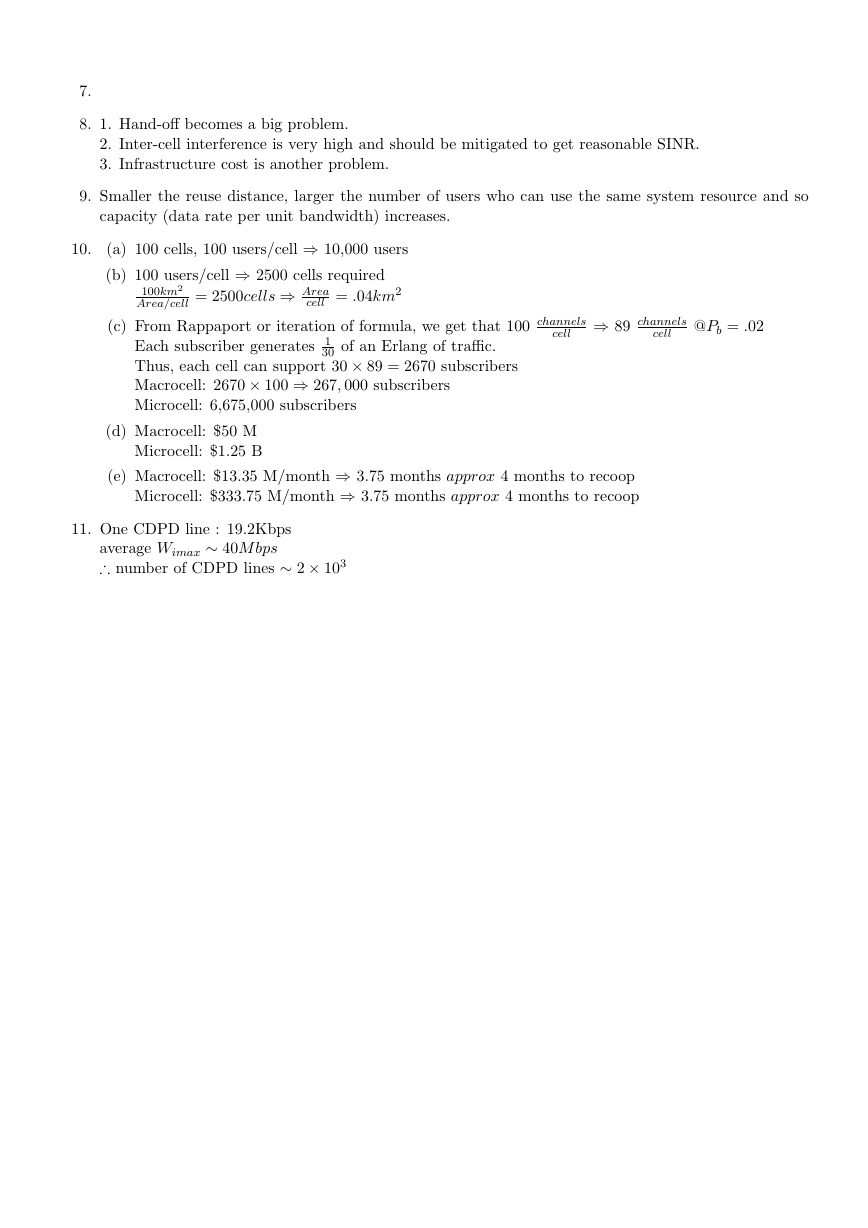
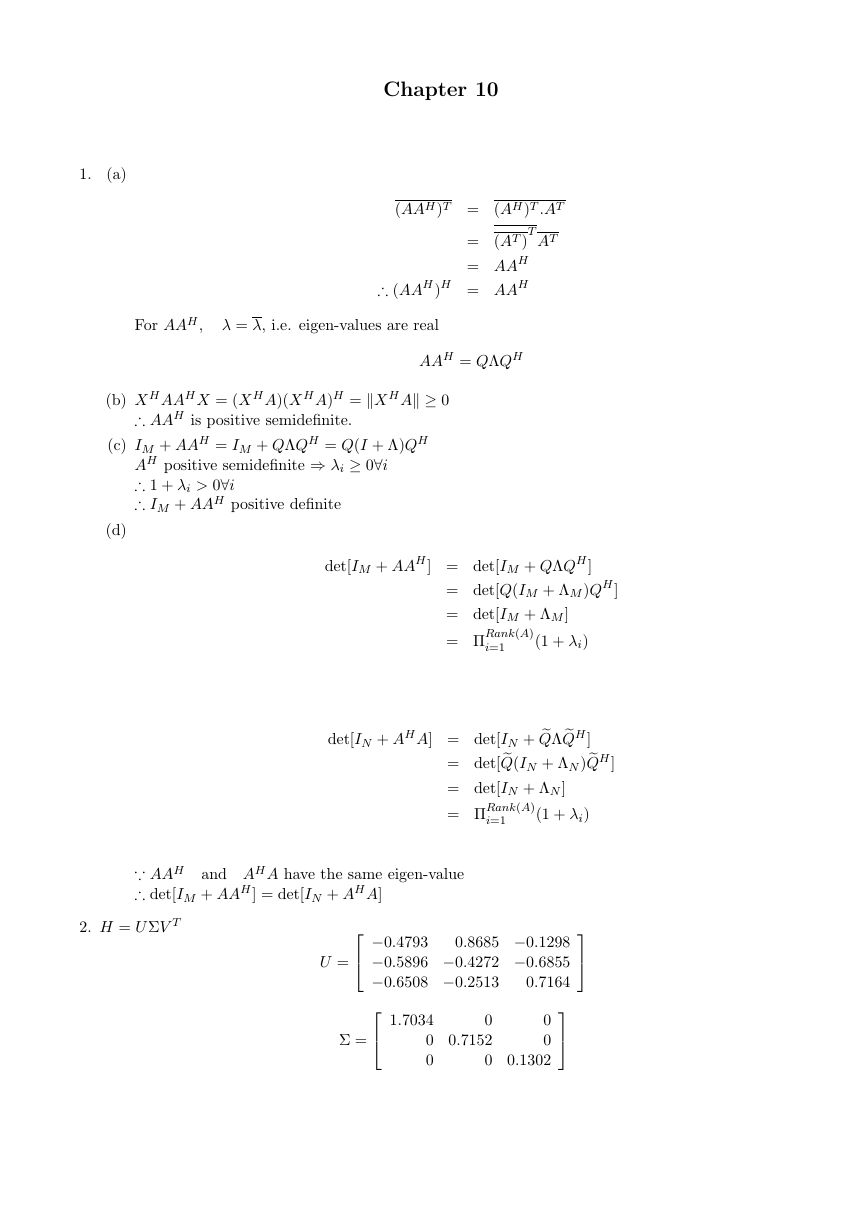

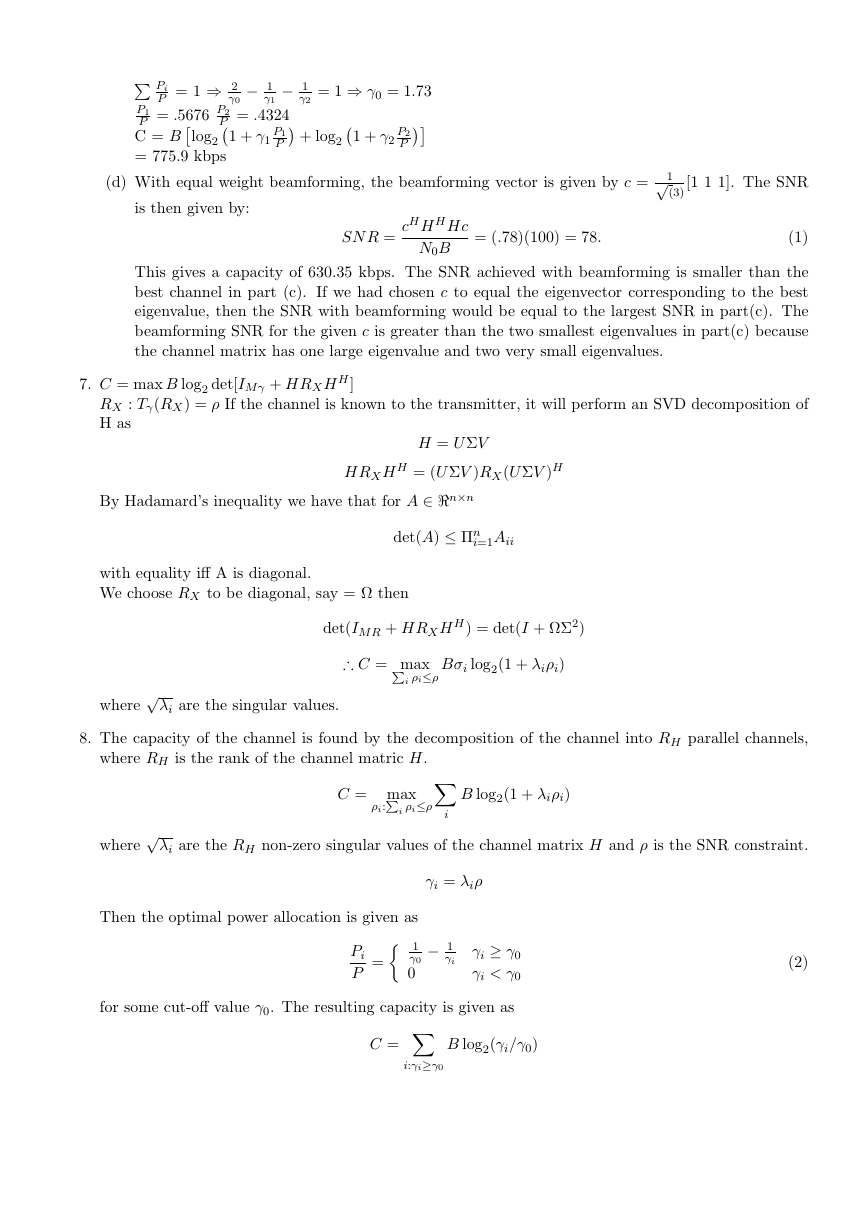
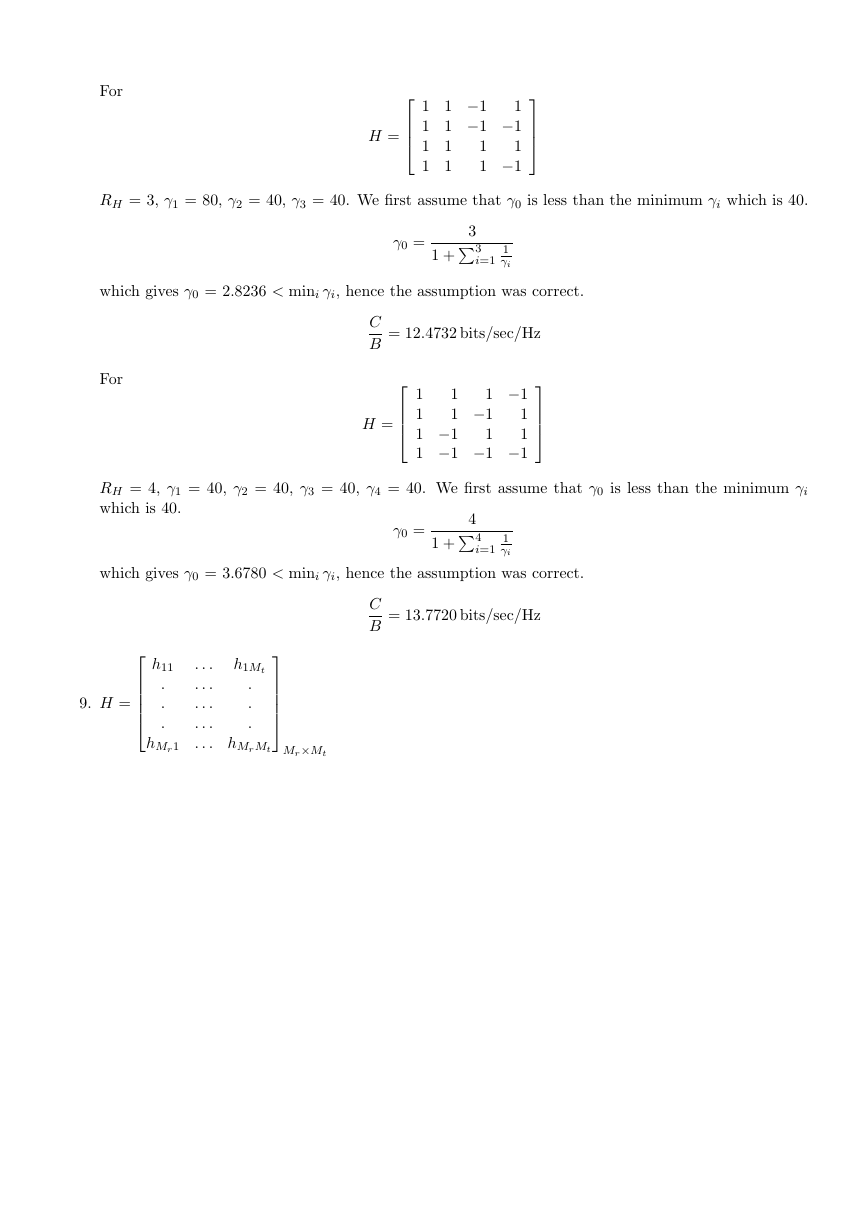

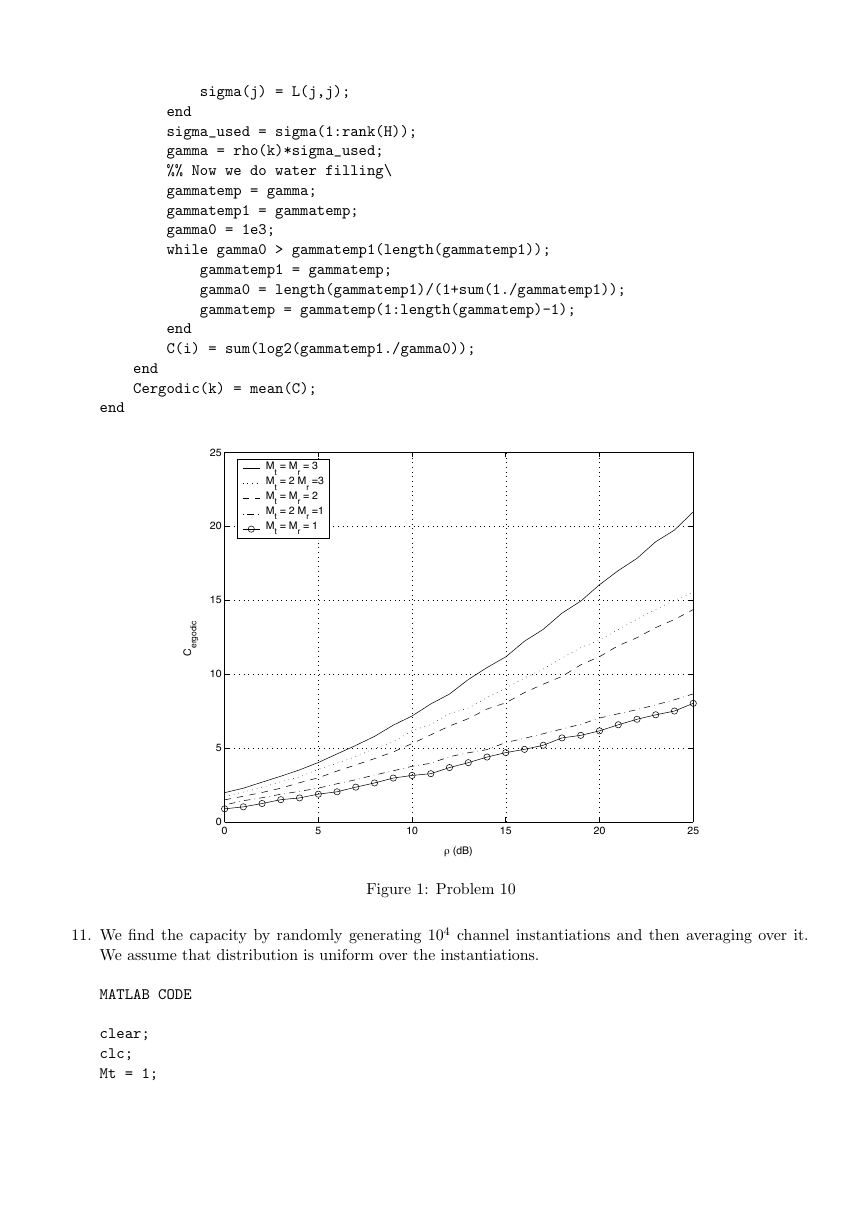








 2023年江西萍乡中考道德与法治真题及答案.doc
2023年江西萍乡中考道德与法治真题及答案.doc 2012年重庆南川中考生物真题及答案.doc
2012年重庆南川中考生物真题及答案.doc 2013年江西师范大学地理学综合及文艺理论基础考研真题.doc
2013年江西师范大学地理学综合及文艺理论基础考研真题.doc 2020年四川甘孜小升初语文真题及答案I卷.doc
2020年四川甘孜小升初语文真题及答案I卷.doc 2020年注册岩土工程师专业基础考试真题及答案.doc
2020年注册岩土工程师专业基础考试真题及答案.doc 2023-2024学年福建省厦门市九年级上学期数学月考试题及答案.doc
2023-2024学年福建省厦门市九年级上学期数学月考试题及答案.doc 2021-2022学年辽宁省沈阳市大东区九年级上学期语文期末试题及答案.doc
2021-2022学年辽宁省沈阳市大东区九年级上学期语文期末试题及答案.doc 2022-2023学年北京东城区初三第一学期物理期末试卷及答案.doc
2022-2023学年北京东城区初三第一学期物理期末试卷及答案.doc 2018上半年江西教师资格初中地理学科知识与教学能力真题及答案.doc
2018上半年江西教师资格初中地理学科知识与教学能力真题及答案.doc 2012年河北国家公务员申论考试真题及答案-省级.doc
2012年河北国家公务员申论考试真题及答案-省级.doc 2020-2021学年江苏省扬州市江都区邵樊片九年级上学期数学第一次质量检测试题及答案.doc
2020-2021学年江苏省扬州市江都区邵樊片九年级上学期数学第一次质量检测试题及答案.doc 2022下半年黑龙江教师资格证中学综合素质真题及答案.doc
2022下半年黑龙江教师资格证中学综合素质真题及答案.doc